If you want an easy to grow trailing plant that looks super unique, you’ll want to check out the Philodendron Brasil! In this post, we’re going to talk about the Philodendron Brasil plant – where it came from and most importantly, how to care for one.
Before we dive in, you may wonder where this plant got its name like I was. If you are familiar with the Brazilian flag, you may already know that three main colors of the flag are blue, green and yellow. This plant’s leaves have strokes of yellow and green, which resemble the Brazilian flag!
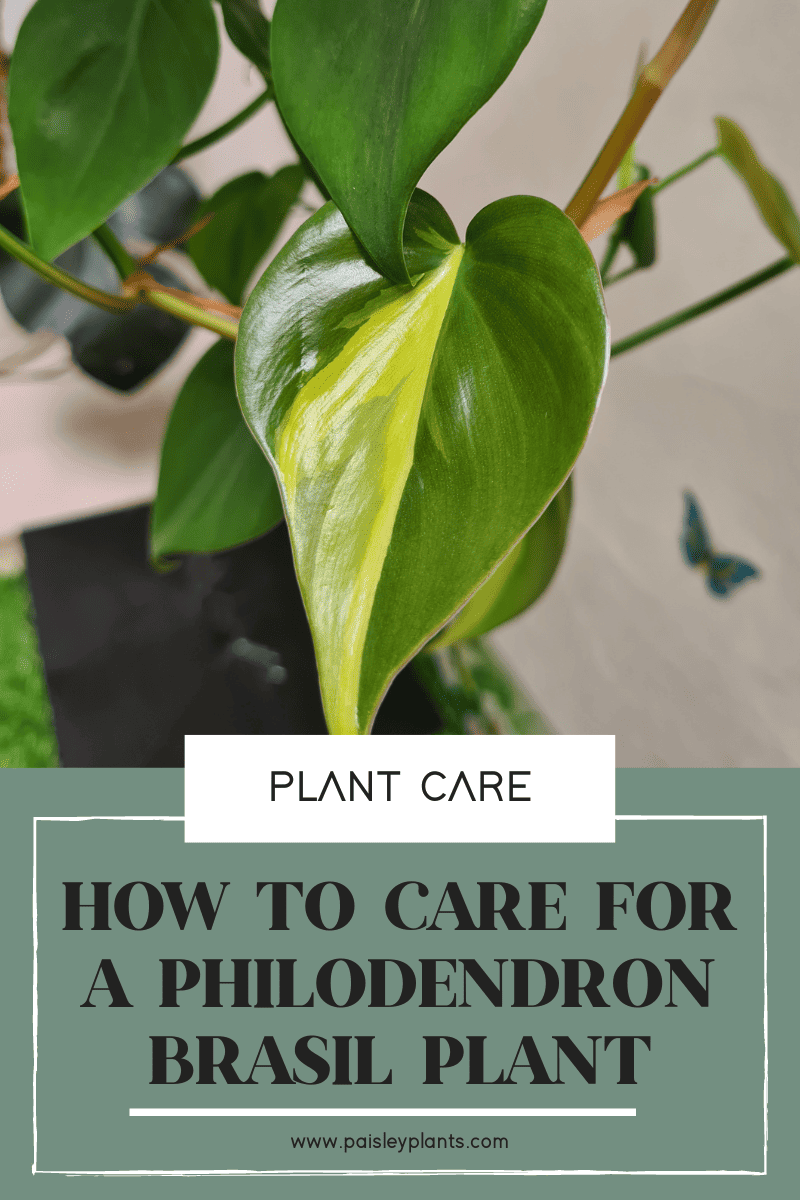
Table of Contents
Philodendron Brasil Background/History
The philodendron hederaceum ‘brasil’ is native to the tropical rainforests of South America. This mutation was discovered in a controlled environment after successive generations of Heartleaf Philodendron propagation. You won’t find this plant growing in Brasil in the wild, even in spite of it being named after the country’s flag colors!
The Philodendron Brasil plant is a gorgeous plant that is relatively easy to grow! Since it is a hanging plant it looks great in a hanging basket to allow it’s long vines to drape down.
Common Names
The Philodendron Brasil is commonly known as the variegated heart leaf philodendron. The variegated leaves where they have the yellow stripe and green tripe that give it its distinctive look.
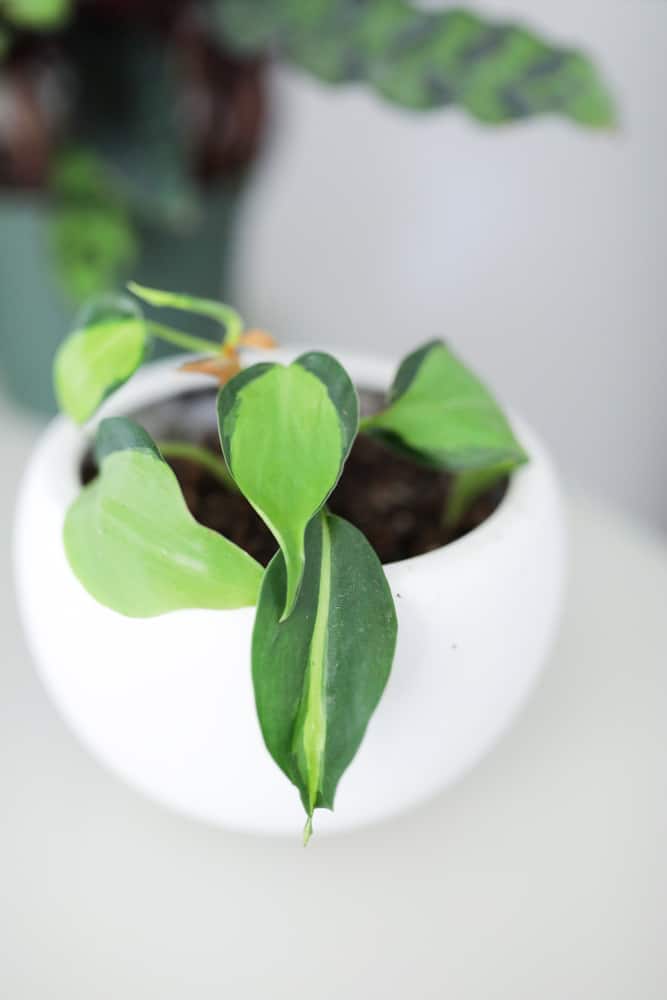
Varieties
While it is very similar to the Brasil pothos plant, there are slight differences. They both have heart-shaped leaves, but the pothos has thicker leaves with a bumpy texture and the philodendron has thinner leaves with a smooth texture.
Toxicity
Philodendrons are toxic to humans, dogs, cats and other animals. They contain calcium oxalate crystals that are toxic when chewed or swallowed. They can cause intense swelling, pain, and irritation of the mouth and gastrointestinal tract, so be diligent about keeping them away from small children or pets.
Philodendron Brasil Care Tips
Here’s how to grow a happy, healthy Philodendron Brasil plant!
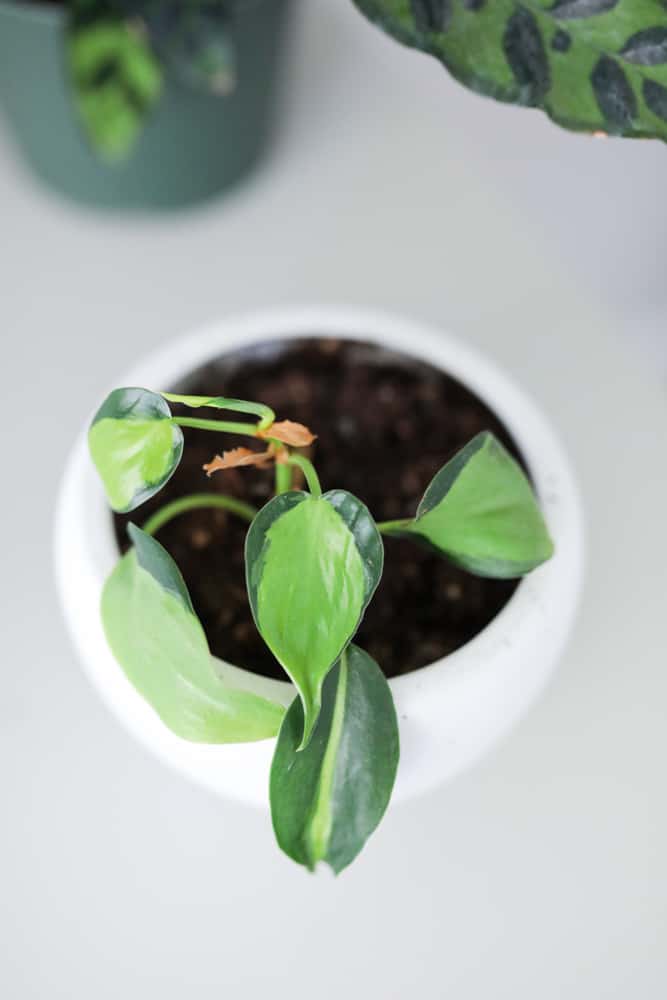
This post includes affiliate links.
Water Requirements
One thing to keep in mind with your Philodendron Brasil is that it is very sensitive to overwatering. You should water it about once a week and avoid allowing it to stand in soggy soil. These plants prefer moist soil, not overly wet. Always use a pot with a drainage hole so excess water can get out of the pot.
Allow the topsoil to dry out completely between waterings. You can test this by sticking your finger into a couple inches of soil to see if it has dried out yet. If so, then it is time to water your plant again. Be sure your pot has good drainage also.
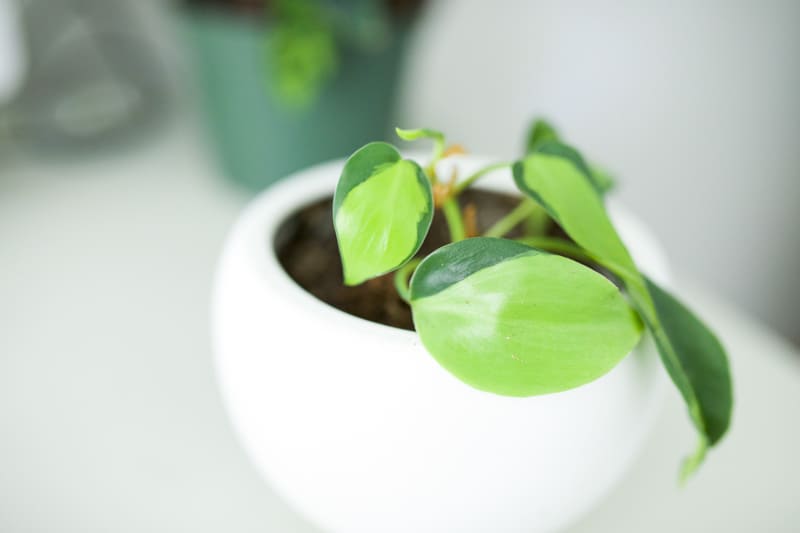
Light Requirements
Your Philodendron Brasil plants can survive as indoor plants in low light conditions, but will grow faster and also will produce more leaves if it is grown in medium to bright indirect light. Also, the variegation will be more pronounced when grown in higher light.
These plants can handle some direct bright light but don’t bake it in the sun all day long or it could burn the leaves. If it does get some direct sun make sure it’s also getting a good amount of indirect sunlight.
When grown in low light conditions, your plant may also become leggy as it will be seeking the light and the stems will stretch to reach it. Having it in higher light conditions will also help it to produce more leaves!
Soil Requirements
The best soil for your Philodendron Brasil is a loose, well draining solid that is rich in organic matter. This can consist of peat moss, perlite, worm castings, lime, and fir bark. You can purchase this commercially or make your own if you have all the right ingredients.
There are also recipes for this type of soil online, so just take a look if you are interested in making some. They also like the soil to be a bit acidic, so you can check for this when looking for or making your mix of soil.
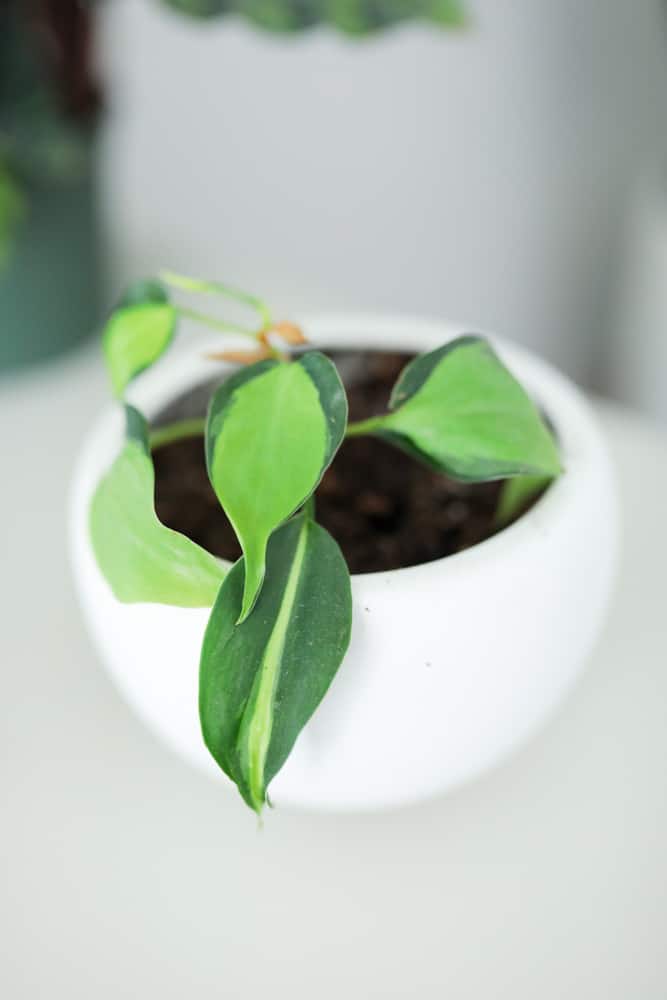
Fertilizing Requirements
It is best to use a weak solution of liquid fertilizer once every two weeks during the growing season or summer months. You can follow the directions on the package of fertilizer for the right mixture of water to fertilizer. Always be sure to stop during the winter months when they are dormant.
Philodendrons are considered to be heavy feeders. They should be fertilized regularly with a balanced fertilizer. A regular feeding program with a nitrogen fertilizer will increase leaf size and produce a larger, healthier plant.
Temperature and Humidity Requirements
The optimum daytime temperatures for your Philodendron Brasil are between 75 and 85 degrees F. The night time temperatures can range between 65 and 70 degrees F.
Most philodendrons prefer high humidity levels between 60% – 70%. If the humidity drops below 50% consistently, this may cause your plant to start showing signs of wilting. Be sure to check the humidity levels by using a digital hygrometer.
These can be purchased online and will help ensure optimum humidity levels for all of your plants. After all, if you invest the time and money into your plant collection, you should also invest the time and money it takes to take good care of them!
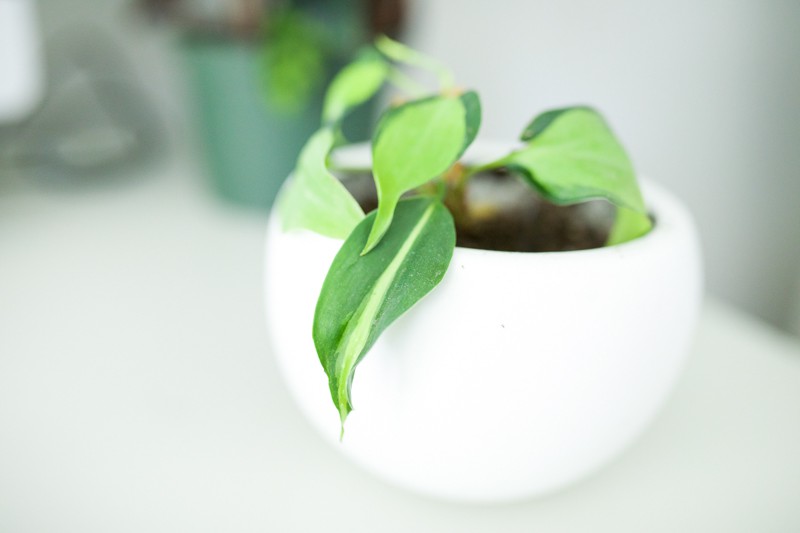
Pests and Diseases
One good feature of the gorgeous Philodendron Brasil is that its tough, waxy leaves help it not be quite as susceptible to pests and diseases as some other plants. Also, their fast growth helps them rebound from losses quickly.
That being said, any plant can fall prey to insects such as aphids, mealybugs, thrips, spider mites, or scale. Flying pests like whiteflies or fungus gnats are other common troublemakers. Keep an eye out when watering your plant for any of these pests and treat them accordingly.
The best method of treating any of these pests is to use rubbing alcohol. Rub the leaves with the alcohol where the pests are and if needed, repeat. You may also need to use neem oil or insecticidal soap if the problem becomes more serious.
The main disease that can affect Philodendron Brasil is Leaf Spot. Overwatering is a huge contributing factor to this problem, so keep close watch on your watering schedule to help prevent this.
Remember that preventing disease is easier than treating one! Some important steps for prevention are:
- Keep your plant healthy. Stress from inadequate care invites disease.
- Watering philodendrons from below reduces wet foliage that can promote fungus
- Sterile tools and potting media eliminate a major source of infection
- Letting soil dry out properly is the best way to prevent disease. It sometimes may even solve the problem.
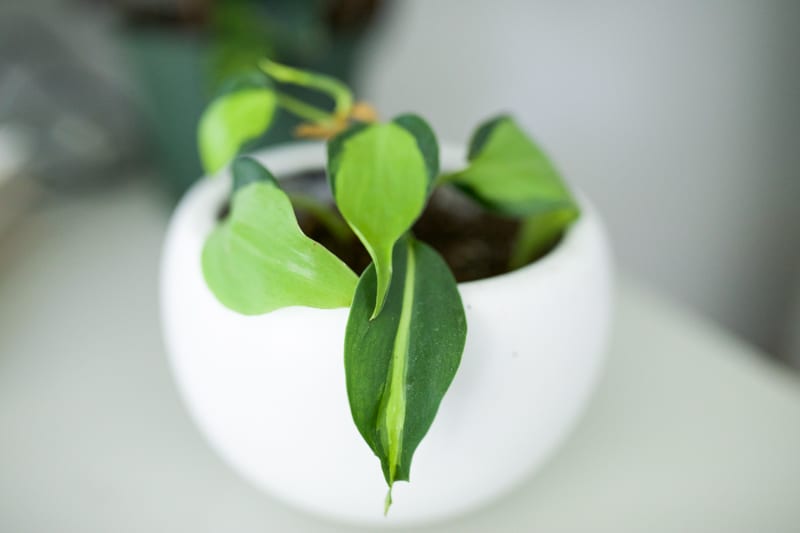
Pruning and Repotting
Pruning your Philodendron Brasil should be done in the spring or fall. You can also give your plant a trim any time of year to remove yellow leaves and trim any spindly growth. This will help keep your plant healthy and also help it to bush out some with new growth.
Stem cuttings can be propagated to create a new plant or two! The easiest way to do this is by sticking the cuttings in water, ensuring the leaf nodes are covered, to allow roots to form. Once the roots are a few inches long you can pot it!
*Find our full Philodendron Brasil propagation guide here!
When you are ready to prune your plant, you should use sterile pruning tools. Wipe the blades with normal alcohol and this should be sufficient to clean the blades. You need to be sure to do this to help prevent spreading any diseases or bacteria that may already be on your plant.
Typically, philodendrons like to be a bit root bound. That will mean that you won’t need to repot your plant more than every other year or so. When you notice slow or stunted growth, or when the roots start to grow out of the drainage hole in the bottom of the pot, it may be time to repot your plant.
If the root ball of your plant is large or if it is compacted, you should trim the roots and loosen up the root ball before repotting. Remove the bottom third of the compacted roots and then repot. Be sure to use new soil also as the old soil will have lost its nutrients about a year into its life.
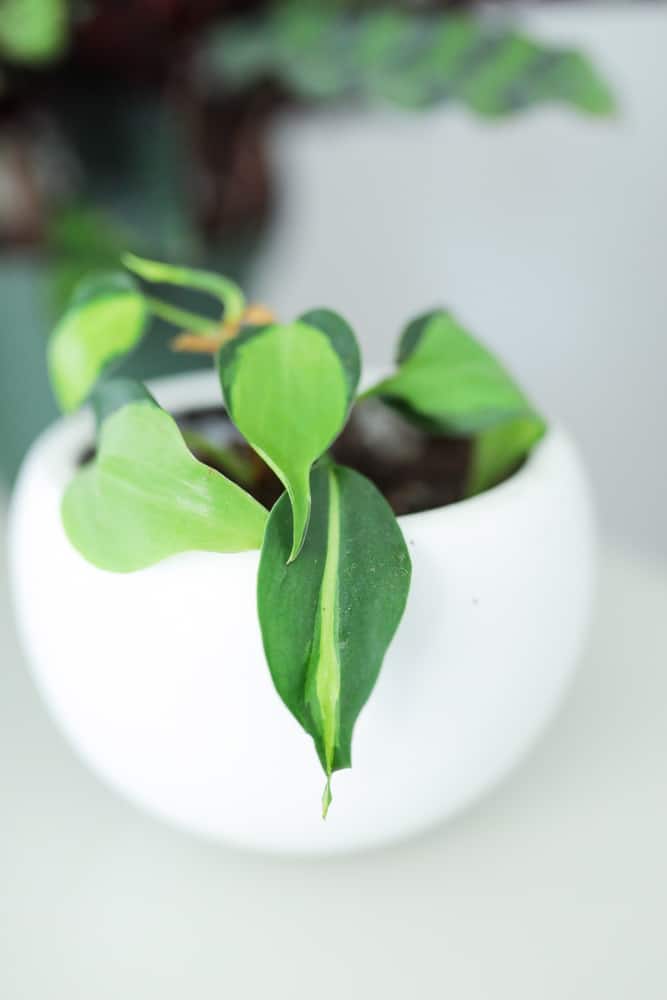
Common Problems
One of the most common problems with a Philodendron Brasil can be low light conditions which can cause the variegation to begin to revert. You won’t be able to see the strong variation in colors that are normal if the light conditions are lacking. Placing your plant back into sufficient light will help reverse this condition.
Lack of light can also produce a leggy plant or small eaves. This is because your plant is seeking out a better light source. Moving your plant to a better light position will also help to remedy this problem. You may also have to trim back or prune your plant once you move it to help it get back to its former shape.
If your plant is dropping leaves, it may be that it is not getting enough light or enough water. This is an easy fix. Water on a regular schedule and change the light source and your plant should begin to thrive again!
Where to Buy
FAQs
Unlike some plants, the Philodendron Brasil don’t need misting on a regular basis. Unless your home is particularly dry, misting isn’t necessary. Of course, you can mist these plants once or twice a week and they won’t mind!
Yes, these plants are a known air cleaner in any indoor space. They help remove pollutants such as formaldehyde from the air when they absorb moisture and release it into a room as clean oxygen.
Leaves tend to curl if the plant is cold or excessively dry from constant air flow. Since these are tropical plants, they will thrive in more humid environments. Keeping them out of the way of air vents and also in a warmer place should help them thrive.
In Conclusion
This beautiful and quite easy to grow plant will be a lovely addition to your home or office. The color variation is a great way to add some additional color to your decor and also add some fresh and air-improving qualities to your space.
As always, keep on growing!
